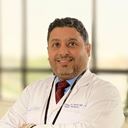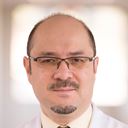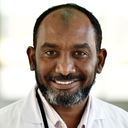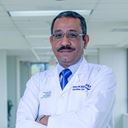
What is cardiothoracic surgery?
Our highly trained and experienced Johns Hopkins Aramco Healthcare (JHAH) heart, chest and lung surgery team is here to help if you are dealing with a disease of the heart that could affect your quality of life and life expectancy. High blood pressure, cholesterol, obesity, diabetes and smoking can all lead to a narrowing or complete blockage of the coronary arteries and put you at risk of a heart attack. Our cardiothoracic surgeons can help. They also treat a wide range of thoracic (chest) diseases and tumors.
What to expect from our cardiothoracic surgery services
Before your heart operation
Our Cardiothoracic Surgery Clinic is not a self-referral service, so your Primary Care physician or other specialist such as your cardiologist, thoracic specialist or neurologist, will make a referral for you if they believe you need a surgeon to evaluate your condition.
When you arrive at the Cardiothoracic Surgery Clinic you will be checked in, and within five minutes our surgical nurse will carry out an initial clinical screening. Wait times are around 15-20 minutes, and your appointment will usually last 20-30 minutes. During your initial consultation, your surgeon will learn about your symptoms, and perform a physical examination in order to determine your health.
You will then be invited to a clinic, usually two to three weeks before your treatment, to ensure that you are well enough for the anesthetic and operation. Before surgery you will need a chest X-ray, blood and urine tests, a nasal swab, and an electrocardiogram (EKG), which records the electrical activity of your heart.
During surgery
The morning of the surgery, your chest, legs and groin will be shaved. You will receive drugs to put you to sleep and to block pain. At the end of the procedure, your breastbone will be wired shut and your wound will be closed with stitches or staples. You may have two or more small pacing wires on your chest. If needed, these wires will be used to help control your heartbeat. They will be removed before you go home. You will have tubes in your chest and be hooked to a machine to drain extra air and blood. The tubes will be taken out in about a day.
After surgery
After surgery, you will be taken to the Cardiac Surgery Intensive Care Unit. When you wake up, the breathing tube inserted in your windpipe during surgery will be removed. You will then have a mask on your face to give you oxygen, which will be replaced by a small oxygen tube once you are breathing well. You must take deep breaths and cough 10 to 20 times an hour to prevent fluid build-up in your lungs. A small gauge, called an incentive spirometer, will show you how deep your breaths are, and help you train yourself to breathe deeply.
The day after surgery you should be able to walk with help. If the bypass vessel was taken from your leg, you may have some swelling. Raise your legs above your heart when sitting and do not cross your legs. After a day or two, you will move to the Cardiac Progressive Care Unit, where you will be for three to five days before going home. We will closely monitor your heart and oxygen levels and also check you for anemia (a low number of red blood cells), which is common but will make you feel tired.
Most of your stitches are inside and will dissolve over time. The staples will be removed five to seven days after surgery. If they are still in when you leave hospital, arrangements will be made for a home health nurse to come to your home to remove the staples (providing your insurance approves it). You will need to see your surgeon about four weeks after you go home. You will receive a letter about this within two weeks. You should arrange a follow-up visit with your own doctor.
What should I watch for?
If your chest wound is painful, hot, red, swollen or it drains, tell your doctor immediately. You should take your temperature twice a day, in the morning and evening. If it goes to 101 Fahrenheit (38 Celsius) or higher, take two paracetamol and call your surgeon at once. You should weigh yourself every morning and should tell your surgeon if you gain more than four pounds in one or two days, notice increased swelling in your legs, or feel short of breath.
Your heart and vascular physicians
How to become a patient at JHAH

Dhahran







